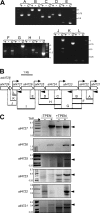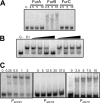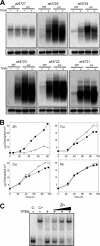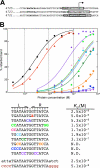Characterization of the response to zinc deficiency in the cyanobacterium Anabaena sp. strain PCC 7120
- PMID: 22389488
- PMCID: PMC3347182
- DOI: 10.1128/JB.00090-12
Characterization of the response to zinc deficiency in the cyanobacterium Anabaena sp. strain PCC 7120
Abstract
Zur regulators control zinc homeostasis by repressing target genes under zinc-sufficient conditions in a wide variety of bacteria. This paper describes how part of a survey of duplicated genes led to the identification of the open reading frame all2473 as the gene encoding the Zur regulator of the cyanobacterium Anabaena sp. strain PCC 7120. All2473 binds to DNA in a zinc-dependent manner, and its DNA-binding sequence was characterized, which allowed us to determine the relative contribution of particular nucleotides to Zur binding. A zur mutant was found to be impaired in the regulation of zinc homeostasis, showing sensitivity to elevated concentrations of zinc but not other metals. In an effort to characterize the Zur regulon in Anabaena, 23 genes containing upstream putative Zur-binding sequences were identified and found to be regulated by Zur. These genes are organized in six single transcriptional units and six operons, some of them containing multiple Zur-regulated promoters. The identities of genes of the Zur regulon indicate that Anabaena adapts to conditions of zinc deficiency by replacing zinc metalloproteins with paralogues that fulfill the same function but presumably with a lower zinc demand, and with inducing putative metallochaperones and membrane transport systems likely being involved in the scavenging of extracellular zinc, including plasma membrane ABC transport systems and outer membrane TonB-dependent receptors. Among the Zur-regulated genes, the ones showing the highest induction level encode proteins of the outer membrane, suggesting a primary role for components of this cell compartment in the capture of zinc cations from the extracellular medium.
Figures






Comment in
-
Zinc starvation response in a cyanobacterium revealed.J Bacteriol. 2012 May;194(10):2407-12. doi: 10.1128/JB.00257-12. Epub 2012 Mar 2. J Bacteriol. 2012. PMID: 22389477 Free PMC article. No abstract available.
Similar articles
-
Molecular basis for the integration of environmental signals by FurB from Anabaena sp. PCC 7120.Biochem J. 2018 Jan 5;475(1):151-168. doi: 10.1042/BCJ20170692. Biochem J. 2018. PMID: 29203647
-
Zur (FurB) is a key factor in the control of the oxidative stress response in Anabaena sp. PCC 7120.Environ Microbiol. 2015 Jun;17(6):2006-17. doi: 10.1111/1462-2920.12628. Epub 2014 Oct 22. Environ Microbiol. 2015. PMID: 25244409
-
Analysis of the Caulobacter crescentus Zur regulon reveals novel insights in zinc acquisition by TonB-dependent outer membrane proteins.BMC Genomics. 2014 Aug 28;15(1):734. doi: 10.1186/1471-2164-15-734. BMC Genomics. 2014. PMID: 25168179 Free PMC article.
-
ATP-binding cassette transporters of the multicellular cyanobacterium Anabaena sp. PCC 7120: a wide variety for a complex lifestyle.FEMS Microbiol Lett. 2018 Feb 1;365(4). doi: 10.1093/femsle/fny012. FEMS Microbiol Lett. 2018. PMID: 29360977 Review.
-
Bacterial zinc uptake regulator proteins and their regulons.Biochem Soc Trans. 2018 Aug 20;46(4):983-1001. doi: 10.1042/BST20170228. Epub 2018 Jul 31. Biochem Soc Trans. 2018. PMID: 30065104 Free PMC article. Review.
Cited by
-
Identification, Functional Characterization, and Regulon Prediction of the Zinc Uptake Regulator (zur) of Bacillus anthracis - An Insight Into the Zinc Homeostasis of the Pathogen.Front Microbiol. 2019 Jan 11;9:3314. doi: 10.3389/fmicb.2018.03314. eCollection 2018. Front Microbiol. 2019. PMID: 30687290 Free PMC article.
-
Structural and mechanistic basis of zinc regulation across the E. coli Zur regulon.PLoS Biol. 2014 Nov 4;12(11):e1001987. doi: 10.1371/journal.pbio.1001987. eCollection 2014 Nov. PLoS Biol. 2014. PMID: 25369000 Free PMC article.
-
Acinetobacter baumannii response to host-mediated zinc limitation requires the transcriptional regulator Zur.J Bacteriol. 2014 Jul;196(14):2616-26. doi: 10.1128/JB.01650-14. Epub 2014 May 9. J Bacteriol. 2014. PMID: 24816603 Free PMC article.
-
Regulation of internal promoters in a zinc-responsive operon is influenced by transcription from upstream promoters.J Bacteriol. 2013 Mar;195(6):1285-93. doi: 10.1128/JB.01488-12. Epub 2013 Jan 11. J Bacteriol. 2013. PMID: 23316045 Free PMC article.
-
Toxicity mechanisms of ZnO UV-filters used in sunscreens toward the model cyanobacteria Synechococcus elongatus PCC 7942.Environ Sci Pollut Res Int. 2019 Aug;26(22):22450-22463. doi: 10.1007/s11356-019-05057-6. Epub 2019 Jun 3. Environ Sci Pollut Res Int. 2019. PMID: 31161548
References
-
- Ausubel FM, et al. 2010. Current protocols in molecular biology. Greene Publishing & Wiley-Interscience, New York, NY
-
- Baichoo N, Wang T, Ye R, Helmann JD. 2002. Global analysis of the Bacillus subtilis Fur regulon and the iron starvation stimulon. Mol. Microbiol. 45:1613–1629 - PubMed
Publication types
MeSH terms
Substances
LinkOut - more resources
Full Text Sources
Other Literature Sources
Molecular Biology Databases

